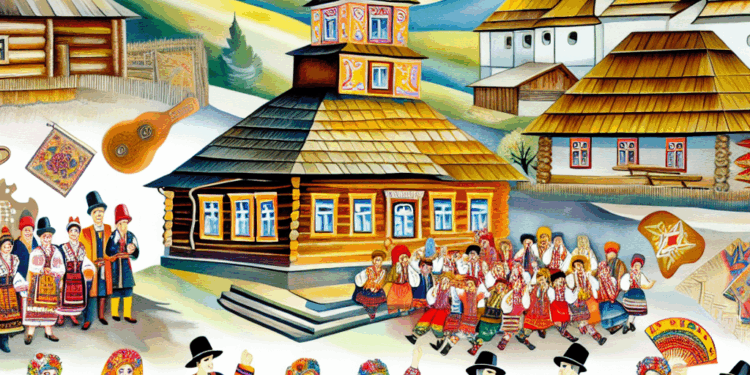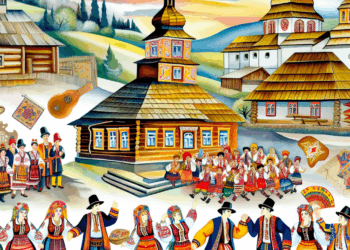Introduction
Bukovina is a region in the Carpathian Mountains, washed by rivers and surrounded by picturesque mountains. It has been home to many peoples, and each has contributed to the rich cultural palette of this land. Ukrainian, Romanian, Jewish and Polish cultures crossed paths here, creating a unique multinational heritage.
Geographical and historical background
Bukovyna is located in the north of Romania and south-west of Ukraine, which accounts for its diversity. Under the influence of different historical stages, the territory of Bukovina has been part of different states: from the Roman Empire and the Ottoman Empire to the Austrian and Soviet Republics. This diversity of cultures is reflected in a special way in traditions, music and even language.
Traditions and holidays
The traditions of Bukovina date back to ancient times and are fundamentally linked to local beliefs. One of the most striking holidays is Sabantui – it is a holiday of spring and harvest day, which is celebrated by Bukovinians at the end of May. On this day, folk festivals with music and dance programmes take place.
Christmas and New Year
Christmas and New Year also play an important role in the culture of Bukovina. The unique tradition of Christmas carols, when adults and children go from house to house singing songs and collecting treats, is an integral part of the festive season. Fairs are also held during this period, where local handicrafts are presented.
Folklore festivals
Folklore festivals take place at various locations throughout the year. For example, the Folk Music Festival in Chernivtsi, the capital of Bukovina, brings together talented musicians from all over Ukraine. These events make it possible to preserve and pass on to the younger generation the unique melodies and dances that originate in a centuries-old tradition.
Folk costumes
Folk costumes of Bukovina beautifully reflect the diversity of cultures. One of the most striking examples is the vyshyvanka, a traditional Ukrainian shirt with hand-embroidered decorations, which has survived in various variants among Ukrainians, Romanians and Poles. In some regions, elements of jewellery with symbols reflecting the beliefs of the people are characteristic.
At festivals, women dress in shirts (long dresses) decorated with colourful embroideries, while men prefer long shirts and wide belts. These costumes are not only a work of art, but also serve as a reflection of the identity of the people.
Crafts
Bukovina is known for its variety of traditional crafts. One of the most popular is pottery. Masters, such as Anatoliy Koval from the village of Repuzhintsy, create unique products on given themes. Potters use local clay to make both utilitarian and decorative items.
Wood carving
Another common craft is wood carving. Craftsmen create exquisite pieces from utensils to interior items. One of the famous masters is Vasyl Melnyk, whose works can be seen at exhibitions and fairs in Bukovina.
Weaving
Weaving also occupies an important place in the culture. Carpets and fabrics created by local craftsmen have unique patterns and colour combinations that are passed down from generation to generation. Women from villages such as Vashkivtsi apply unique weaving techniques, creating a true art.
Music and folklore
The music of Bukovina is a combination of melodies, dances and rituals unique to each nation. Traditional instruments such as wind and string instruments are actively used in local folk art.
Traditional music
The most important part of music is brass bands, which perform at festivals, weddings and other significant events. Local folk tunes are often simple and melodic, conveying mood and atmosphere.
Dances
Dance too plays an important role in cultural life. One of the most popular dances is the Hutsulka Xenya, which is performed both at weddings and folk festivals. It is an energetic dance that requires a lot of physical effort and skill.
Influence of other cultures
Bukovina is a place where different cultures intersect. Romanian, Ukrainian, Jewish and Polish cultural traditions enrich each other, creating a unique atmosphere.
Ukrainian culture
The heritage of Ukrainian culture can be seen in the language, folk festivals and customs. Local Ukrainians preserve their traditions, passing them on to the next generations. For example, icons can be seen in every home, and the custom of celebrating winter Holy Days can be followed.
Romanian culture
Romanian language and customs also play an important role in the lives of the locals. The mixture of Romanian and Ukrainian traditions is particularly evident in the cuisine, for example in dishes such as sarmale (stuffed cabbage) and mămăligă (corn porridge).
Jewish culture
The Jewish community, once significant in Bukovina, has left its mark in architecture, music and cuisine. Traditional Jewish holidays such as Hanukkah and Passover were celebrated among the local Jewish communities, fostering cultural exchange.
Polish culture
Polish culture is also evident in architecture and folklore. For example, melodies typical of Polish folk songs can be heard in some villages. Many Polish surnames can be found among the locals, which confirms the close ties between these peoples.
Conclusion
The culture of Bukovina is a rich multinational heritage, where traditions, customs and crafts of different peoples are intertwined. Each event is not only fun, but also an important part of history that should be preserved and passed on from generation to generation.
Like Bukovina itself, these cultural gems have their own unique beauty. Thanks to the efforts of craftsmen, musicians and ordinary people, this heritage continues to live and develop, reminding us all of the importance of respecting the diversity of cultures.
Bukovina, strange as it may seem, becomes a symbol of unity and harmony, where each nation contributes to the common heritage, thus creating a wonderful canvas of human experience and understanding.








